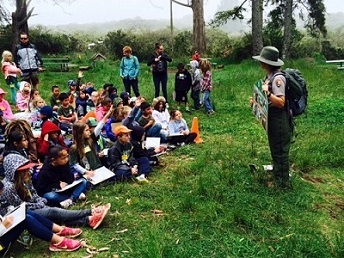Last updated: April 10, 2020
Lesson Plan
Mālama Maui

- Grade Level:
- Lower Elementary: Pre-Kindergarten through Second Grade
- Subject:
- Science
- Lesson Duration:
- 60 Minutes
- State Standards:
- Hawai‘i Content and Performance Standards III:
SC.K.1.2, SS.K.5.2, SS.1.4.1, SC.2.8.2, SS.2.3.1, SS.2.7.4 - Thinking Skills:
- Remembering: Recalling or recognizing information ideas, and principles. Understanding: Understand the main idea of material heard, viewed, or read. Interpret or summarize the ideas in own words. Creating: Bring together parts (elements, compounds) of knowledge to form a whole and build relationships for NEW situations. Evaluating: Make informed judgements about the value of ideas or materials. Use standards and criteria to support opinions and views.
Essential Question
How does Haleakalā National Park protect the environment and the species that live in them?
What can students do each day to protect the environment and the species that live in them?
Objective
At the end of this lesson, the students will be able to determine how Haleakalā National Park protects special native habitats and how the students can help protect them too.
Background
On our field trip to Haleakalā, we learned about many ways that the National Park Service helps protect special native habitats found nowhere else on earth. It is our kuleana (responsibility) to care for Haleakalā National Park. In what ways can we help?
Preparation
Materials Needed:
Mālama Maui letter to parents (included)
Materials
Mālama Maui letter to parents with instructions
Download Mālama Maui letter to parents
Procedure
Step 1: Introduction
Generate a discussion about mālama or caring. Ask children to describe how they take care of other things in their lives (ex: pets, siblings, toys, gardens).
Step 2: Reflect on Haleakalā National Park’s protection efforts
Have students remind you of some of the native species that are found in Haleakalā National Park. Generate a list of how Haleakalā National Park helps protect the special habitats of these native species.
- Stay on the trail rule
- Cattle fences
- Relocating 4-legged animals
- Planting native plants
- Educating people
Step 3: How can students help protect native habits?
Ask students how they can help protect the special habitats of native species at Haleakalā National Park:
- Respecting all living creatures
- Telling friends to respect creatures
- Picking up litter
- Brush boots
- Sharing with others about Maui’s special native plants and animals and fragile native habitats
- Staying on trail
- Leave no trace
Step 4: What else can students do to help?
Ask students how they can help protect the environment at home or at school:
- Reduce, Reuse, Recycle
- Eat locally grown foods
- Conserve water
- Conserve electricity
- Water plants
- Grow a garden
- Carry a reusable water bottle
- Take reusable lunch containers
- Leave places better than you found them
Step 5: Explain Homework
Hand out the letter for students to take home to parents. Ask students to perform at least one act of caring for the environment and to be prepared to tell their classmates about their efforts on the following day.
Step 6: Next Day Discussion
When students report on their efforts, make a class list of all of their caring actions and discuss their feelings about these actions.
Possible Discussion Questions:
- Was your helping action easy or difficult?
- Did you give up something in order to care for the environment? Was it worth it?
- What kinds of things could you do for the environment every day?
- How could you interest other friends and family members in helping nature and protecting the habitats of native species?
Vocabulary
Kuleana: Responsibility.
Mālama: To care for or take care of.
Native: Plants and animals that got to Hawai’i by themselves, without the help of people.
Non-native: Plants and animals that are brought to an area by people, either on purpose or accidently.
Additional Resources
Adapted from ‘Ōhiʻa Project. (1989). “M” is for mālama. An environmental education guidebook for Hawaiʻi (pp. 157-160). Honolulu, HI: Bernice Pauahi Bishop Museum and Moanalua Gardens Foundation.
